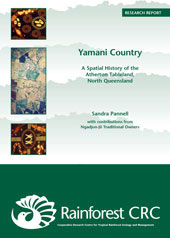 |
||||
 |
Back to Research Report Series |
|||
| Report
No. 43 Yamani Country: A Spatial History of the Atherton Tableland, North Queensland Research Report Sandra Pannell, with contributions from Ngadjon-Jii Traditional Owners ISBN 0 86443 754 4 |
||||
| Extract
from Chapter One Auntie Emma Johnston,
now in her late eighties, is looking at an old black and white photograph
taken some time around 1900. It depicts a group of Aboriginal men and
women in a clearing. Some of the men are standing, holding decorated
shields and spears, and adorned with white cockatoo feather headdresses
and pearl-shell pendants. Others in the group are sitting, long wooden
swords and grass baskets loosely held on their laps. In the background
a tangle of rainforest trees, though it is apparent that some have been
thinned and even removed. Although the photograph labours to give such
an appearance, there is nothing pristine or pre-contact about this scene.
The caption on the photograph reads 'Bellenden Ker Blacks', though Auntie
Emma knows better than this. Carefully reading the designs on the shields
and the ritual cicatrices on the men's bodies, and noting the other
forms of material culture displayed in the photograph, Auntie Emma declares
the people in the photograph to be "Ngadjon-Jii, my mob".
|
 |
|||
|
Download
Full Report
(58.69 Mb) |
||||
|
See below left to download sections. |
||||
| Back to top | ||||
 |
||||